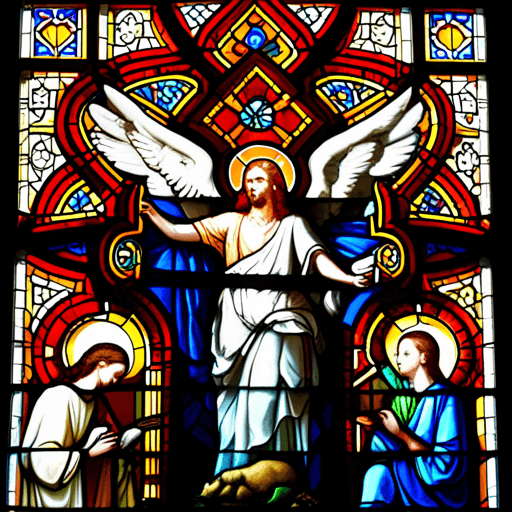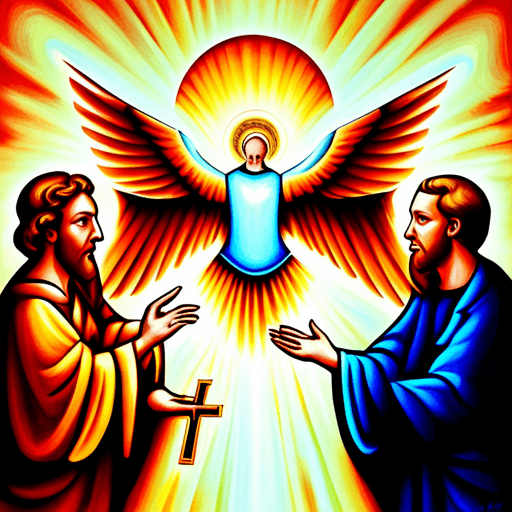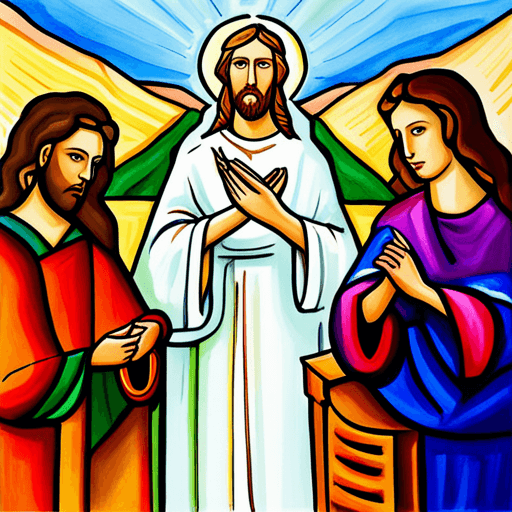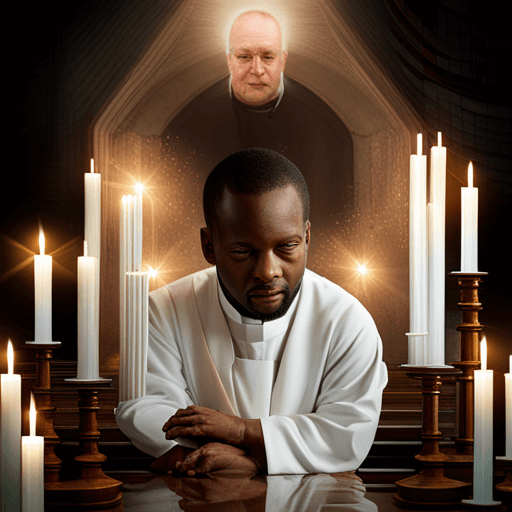Have you ever walked into a Catholic church and been drawn to the colorful, intricate stained glass windows? These beautiful works of art have been a part of Catholic church architecture for centuries. But what do they mean? What is their purpose?
The meaning behind stained glass windows in Catholic churches goes beyond mere decoration. They serve as visual representations of biblical scenes, saints, and religious symbolism. The colors and shapes used in these windows also hold great significance.
Through these carefully crafted pieces of art, the spiritual experience of worshipers is enhanced, providing a sense of community and belonging within the Church. In this article, we will explore the history and symbolism behind stained glass windows in Catholic churches to gain a deeper understanding of their significance in our faith.
History of Stained Glass Windows in Catholic Churches
It’s fascinating to learn about the origins and evolution of stained glass windows in Catholic churches. The tradition of using stained glass windows dates back to the 4th century, when they were used in churches to depict biblical scenes for an illiterate population.
It was a way to teach and inspire people through visual storytelling. Over time, stained glass windows evolved into works of art that not only depicted biblical stories but also showcased the beauty of nature and humanity.
The use of vibrant colors, intricate designs, and symbolic imagery made them an integral part of Catholic church architecture. Today, these beautiful works of art continue to inspire awe and wonder among believers and non-believers alike.
They serve as a reminder of the rich history and tradition that surrounds these houses of worship, while also celebrating the beauty of human creativity.
Depictions of Biblical Scenes and Saints
As you walk through the church, you’ll see vibrant depictions of Biblical stories and revered saints adorning the stained glass panels. These windows are not just decorative pieces, but they serve a greater purpose in conveying the teachings of Catholicism to its followers.
The use of artistic techniques such as color, composition and light create an emotional impact that helps bring these stories to life. The cultural influences behind these windows are also significant.
During medieval times, when most people were illiterate and unable to read religious texts themselves, stained glass windows provided a visual representation of important biblical events and figures. They were used as a tool for education and inspiration for the masses.
Today, stained glass windows continue to be an important part of Catholic churches worldwide as they provide a glimpse into the rich history and traditions of this ancient religion.
Symbolism in Stained Glass Windows
Let’s explore the symbolism found in these beautiful works of art, which reveal deeper spiritual truths and convey important messages to those who view them. Stained glass windows are not merely decorative elements or artistic creations; they hold a significant cultural and religious significance.
The use of colored glass, intricate patterns, and artful techniques all contribute to the spiritual message conveyed through these windows.
One of the most essential symbols shown in stained glass windows is light. Light represents God’s grace and presence, illuminating our lives with wisdom and hope. It also serves as a reminder that we should be lights for others, reflecting God’s love in our daily lives.
The colors used in stained glass also have symbolic meanings; red signifies sacrifice, blue represents divine love, green symbolizes growth and life, purple indicates royalty and penance while gold signifies heavenly glory. These colorful combinations create an aura of transcendence that draws us closer to God as we gaze upon them.
Thus, stained glass windows become a powerful tool for worshipers to connect with their faith on a profound level.
The Role of Color and Shape in Stained Glass Windows
You’ll notice how the colors and shapes in stained glass windows work together to create a sense of divine beauty that transcends earthly limitations. The use of color psychology is integral in conveying the intended message and evoking the desired emotions in the viewer.
Different colors are associated with different meanings, such as blue representing heaven, red symbolizing sacrifice and love, and green representing growth and renewal.
Moreover, geometric patterns play an essential role in creating a harmonious balance between form and function. These intricate designs not only enhance the overall aesthetic appeal but also reflect the underlying religious motifs.
For instance, circular shapes represent continuity and infinity, while triangles symbolize the Holy Trinity. The use of such patterns is not arbitrary but carefully chosen to convey specific religious messages while simultaneously adding to the visual allure of these magnificent works of art.
Enhancing the Spiritual Experience Through Stained Glass Windows
Enhancing the spiritual experience is achieved through the intricate use of color psychology and geometric patterns in stained glass windows. The colors used in stained glass windows have significant meanings that can influence one’s emotions, feelings, and beliefs. For example, blue represents heaven and divinity while red symbolizes sacrifice and love. Yellow represents light and hope while green signifies growth and renewal.
Moreover, the cultural significance of stained glass windows also plays a vital role in enhancing one’s spiritual experience. These windows depict important religious narratives, saints, angels, or biblical scenes that serve as visual representations of faith for believers. Stained glass windows also reflect the rich history of Catholicism as they were first introduced during medieval times when many people couldn’t read or write.
Thus, these beautiful pieces of art served as a way to communicate stories from scripture to individuals who may not have been able to understand them otherwise. Overall, the combination of color psychology and cultural significance makes stained glass windows an essential part of Catholic churches’ architecture that enhances the spiritual experience for all who enter their doors.
Frequently Asked Questions
What is the process for creating stained glass windows in Catholic churches?
If you’ve ever entered a Catholic church, chances are you were struck by the beauty of its stained glass windows. But have you ever wondered how they’re made?
Glass cutting techniques have been refined over centuries to create intricate designs and vibrant colors that capture the eye. The process begins with choosing the right type of glass and then sketching out the design.
Next comes glass cutting, which requires precision and patience. Once each piece has been cut, it’s time to assemble them using lead strips or copper foil.
Finally, the finished product is installed in a frame and placed in its designated spot within the church. While there’s no denying their aesthetic appeal, stained glass windows also hold historical significance as they were once used to teach biblical stories to those who could not read or write.
They continue to serve as a reminder of the role religion has played throughout history and remain an important aspect of Catholic tradition today.
Are there any famous stained glass windows in Catholic churches around the world?
Imagine standing in the grand halls of a Catholic church, gazing up at the magnificent stained glass windows that adorn the walls.
These intricate works of art are not only visually stunning but also hold great symbolic meaning.
Some famous examples include the rose window in Notre Dame Cathedral and the windows in Chartres Cathedral.
Each piece tells a story, often depicting biblical scenes or saints, serving as a visual representation of faith.
The colors used in stained glass have their own significance as well, with red representing love and sacrifice and blue symbolizing heaven and eternity.
By admiring these masterpieces, you can connect with a rich history of religion and find a sense of belonging within your faith community.
How do stained glass windows in Catholic churches differ from those in other religious buildings?
As you gaze upon the intricate stained glass windows of a Catholic church, you may wonder how they differ from those in other religious buildings. These windows hold deep symbolic meaning and historical significance that set them apart.
Each piece of colored glass represents a different aspect of Catholicism, such as the saints, biblical stories, and important events in Church history. The use of stained glass in Catholic churches dates back to medieval times when illiterate people relied on these visual aids to learn about their faith.
Today, these windows continue to serve as a powerful tool for conveying religious teachings and inspiring devotion among believers. By gazing upon the radiant colors and intricate designs of these masterpieces, you can feel a sense of belonging to a timeless tradition that stretches back through centuries of human history.
What is the significance of the location of stained glass windows within a church?
When you step inside a Catholic church, have you ever noticed the location of the stained glass windows? They’re not randomly placed but rather strategically positioned to convey a symbolic meaning and historical significance.
The windows usually adorn the walls surrounding the altar, where the sacraments are celebrated. This placement aims to draw attention to the sacred space and highlight its importance in Catholic worship.
Additionally, these colorful panes often depict scenes from biblical stories or saints’ lives that connect to specific religious themes or events in history. Therefore, stained glass windows serve as visual aids that help Catholics understand their faith better and feel a sense of belonging within their community’s rich traditions.
How have advancements in technology affected the creation and preservation of stained glass windows in Catholic churches?
As technology advances, the creation and preservation of stained glass windows in Catholic churches have become more sustainable and efficient.
There has been a revival of interest in this traditional art form, with new techniques allowing for more intricate designs to be created with greater precision.
Sustainability measures such as using recycled materials and energy-efficient lighting systems have also been implemented to reduce the environmental impact of these beautiful displays.
Despite these advancements, the significance of stained glass windows remains rooted in their ability to evoke a sense of awe and wonder, inviting worshippers to connect with something greater than themselves.
Whether depicting biblical scenes or abstract patterns, these works of art continue to inspire and uplift those who view them.
Conclusion
As you take in the beauty and intricate details of stained glass windows in Catholic churches, it’s important to understand their deeper meaning.
These windows have been a part of church architecture for centuries, serving as a visual representation of biblical stories and saints, as well as symbols that enhance the spiritual experience.
The history of stained glass windows dates back to medieval times when they were used to teach illiterate congregations about religious stories.
Over time, they became more elaborate and ornate, depicting not only scenes from the Bible but also saints who had significant roles in Christian tradition.
The colors used in these windows were carefully chosen to convey specific messages and emotions while the shapes themselves were designed to create a sense of harmony and balance within the space.
In today’s world where we are constantly bombarded by technology and distractions, taking a moment to appreciate the beauty of stained glass windows can be a powerful reminder of our spiritual roots.
By immersing yourself in their intricate designs and symbolism, you can connect with your faith on a deeper level and feel a sense of peace that comes from being surrounded by something so awe-inspiring.
So next time you find yourself in front of one of these stunning creations, take a deep breath and allow yourself to fully absorb its message – it may just be exactly what your soul needs.




